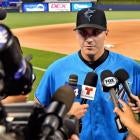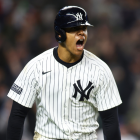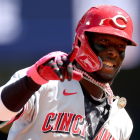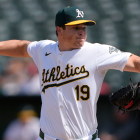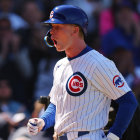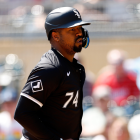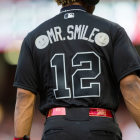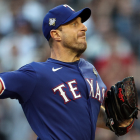With the regular season concluding, we've decided to take a look at each team's future -- not by using a crystal ball or other psychic abilities, but by evaluating their farm systems. Below you'll find our ranking of the top five prospects in the organization -- sorted by perceived future potential -- as well as five other players who fit various categories. Those categories are:
2020 contributor: A player who is likely to play a role for the big-league team next season.
Analyst's pick: A player who is a strong statistical performer and/or whose underlying measures are better than the scouting reports suggest.
Riser: A player on the way up.
Faller: A player on the way down.
One to watch: An interesting player to keep in mind (for whatever reason).
These rankings were compiled after talking with various industry sources about the systems (and players) in question. It should be acknowledged that this process is more art than science, and that there are limits to ordinal rankings. Still, it's an intuitive system, and our hope is that the write-ups will answer any questions by providing additional context and analysis of each player -- such as their pluses and minuses; the risk factors involved; and their estimated arrival date.
One last word on eligibility: we're following MLB's rookie guidelines by disqualifying any player with more than 130 big-league at-bats or 50 innings pitched.
Fiona Apple allegedly wrote "Criminal" in 45 minutes. The Miami Marlins didn't pull off a feat that impressive in 2019, but they did remake the top of their farm system through trades and the draft. As with the song, there's a sense of danger with this system -- nearly every player has a wide range of potential outcomes. If things break right, the Marlins have a chance to graduate a number of quality players over the coming season or two.
Let's take a look at the best prospects in Miami's system:
1. JJ Bleday, OF
When Vanderbilt outfielder JJ Bleday was picked fourth overall by the Marlins in June's draft, he became the third Commodore hitter to ever go in the top five, joining Braves shortstop Dansby Swanson (No. 1, 2015) and former Pirates slugger Pedro Alvarez (No. 2, 2008).
Based on Bleday's pedigree and collegiate performance -- he hit .350/.464/.717 with 26 home runs and one more walk than strikeout -- it would've been justifiable to expect him to walk all over Florida State League pitchers. He didn't, instead posting a .690 OPS in 38 games.
Scouts aren't ready to forget about Bleday -- rather, they maintain hope that he develops into a middle-of-the-order hitter who marries a smart approach with above-average left-handed thump -- but there is some reason for concern here as it pertains to his unorthodox swing.
Typically scouts like quietness at the dish; Bleday's swing features a lot of movement, a lot of reverb. He also tends to collapse his back side, leading at least one talent evaluator to question how he'll fare against better pitchers who can spam him away with soft stuff.
It's to be seen if that anxiety is merited. For now, Bleday remains the safest quantity here.
2. Sixto Sanchez, RHP
The headliner in the J.T. Realmuto trade, Sixto Sanchez is one of the most exciting pitching prospects in baseball. He can hit 100 mph; he flashes above-average secondaries; and he possesses above-average command and control. So, why's he second?
Foremost, Sanchez is on the smaller side. He's officially listed at 6-foot, yet is believed to be even shorter. Historically, teams have not afforded pitchers of that stature a long look in the rotation. The Marlins could prove to be the exception -- they've permitted 6-foot, 180-pound Jordan Yamamoto the opportunity to start -- but there's always something to be said about hedging bets. (Sanchez, for his part, did throw a career-high 114 innings this season.)
There's also the fact that Sanchez, for all his stuff and polish, doesn't miss as many bats as expected -- not even with his fastball. More goes into being a successful pitcher than whiff rates, and it's possible he'll become one of the masters of the freezeball -- the way David Price, who as a youngster missed bats at a lower rate than Jamie Moyer, was in his heyday. Until he proves as much against big-league hitters, it's fair to have some reservations.
Sanchez will open the year in Triple-A. He ought to debut come summertime at the latest.
3. Jesus Sanchez, OF
Earlier this year, one talent evaluator familiar with trade talks involving Jesus Sanchez described him as "the best prospect nobody wants." It turns out someone wanted Sanchez after all, as the Marlins acquired him (and Ryne Stanek) from the Rays at the trade deadline in exchange for Nick Anderson and Trevor Richards. The deal thus far favors Tampa Bay, but Sanchez could change that.
The main reason Sanchez was deemed undesirable by other clubs is because his main strength -- his bat -- doubles as a question mark. In theory, he has the potential to hit for a high average and bop 25-plus home runs a season. In practice, his approach limits his on-base percentage, and he's yet to look the part against upper-level minor-league pitchers. Put another way, Sanchez over the last two seasons has 259 plate appearances where he's performed well-below-average and 316 where he's performed like someone of his stature should.
Sanchez will likely debut in the majors next season as a 22-year-old, but the cone of outcomes remains obtuse. He could be the next Avisail Garcia -- with whom he shares similar launch angles and exit velocities -- or he could mimic prime Matt Kemp if he maxes out. Don't feel bad if that seems like too much risk to value properly -- a number of teams agreed.
4. Jazz Chisholm, SS
Jazz Chisholm was another high-beta deadline get by the Marlins, who nabbed him from the Diamondbacks in exchange for rookie starter Zac Gallen.
Chisholm is a 21-year-old shortstop who may develop four above-average tools. Savvy readers will ask, what's the catch? After all, young players with that kind of potential don't get moved in one-for-one deals often. Well, the catch is his lacking hit tool, the most important of them all -- to wit, he's yet to fan less than 27 percent of the time in any of his pro seasons.
Chisholm did see his strikeout rate dip following the trade, declining from 33.8 percent in Double-A with the Diamondbacks to 25.5 percent in Double-A with the Marlins, but on the year he still finished with the eighth-highest K rate among qualified batters. Chisholm, who stands as still as a gargoyle until beginning his load, remained a plus hitter thanks to his power output. Yet it's not a given that will remain the case as he climbs farther up the organizational ladder.
If the Marlins can help Chisholm rein in some of his strikeout woes, he could be their shortstop of the future -- and quite a good one, at that.
5. Monte Harrison, OF
Guess what -- Monte Harrison is both a trade acquisition (the Christian Yelich deal) and an attrition risk due to his contact woes. How original, right?
Harrison will become the last member of the Yelich bounty to reach the majors when he does so in 2020, joining Lewis Brinson, Isan Diaz, and Jordan Yamamoto. He would've been up in 2019 had he not missed significant time due to injury -- those with functioning memories may recall he was involved in an odd sequence that saw him attempt to switch-hit due to a bum wrist.
Harrison, like Brinson, has a wide berth due to his secondary skills. He can play center field, throw the ball hard and long, and make an impact on the basepaths. He also has above-average power potential, making him a 20-20 threat at his peak. Alas, Harrison fanned 37 percent of the time during his first season in the system, and -- despite improving upon that mark in 2019 -- still struck out in 30 percent of his trips to the plate in 2019.
Interestingly, Harrison made some other perceivable tweaks to his game. He boosted his walk rate and altered his batted-ball profile, hitting the ball on the ground more often and pulling pitches less often. The latest launch-angle revolution icon origins tale, this is not. All the same, Harrison should spend a fair chunk of 2020 serving as Miami's center fielder. If his bat can find the ball frequently enough, he could keep that gig for many years to come.
2020 contributor: Nick Neidert, RHP
A piece of the Dee Gordon trade, Nick Neidert likely would have debuted in 2019 were it not for a knee operation that cost him part of his season. He's a command-and-changeup right-hander with a short arm stroke -- similar to Joe Kelly or Lucas Giolito -- who is going to have to prove his so-so arsenal can play against big-league hitters before anyone regards him as more than a back-end option. He should get a look early on.
Analyst's pick: Robert Dugger, RHP
Another part of the Gordon payout, Robert Dugger did reach the Show in 2019, posting a rich ERA and a poor strikeout-to-walk ratio. He's the pitcher on the Marlins staff most likely to be confused with Yamamoto since he too is a slender right-hander without top-flight stuff. Dugger doesn't throw hard but he has a deceptive delivery (complete with a nearly sidearm release point) and an above-average slider. Batters whiffed more than 40 percent of the time they offered at his slide piece, which boasts two-plane movement and checks in at speeds more befitting of a slurve, putting him in a rate class with the likes of Trevor Bauer, Matthew Boyd, and Dakota Hudson. (Small sample caveats apply.) Though Dugger is probably just a reliever over the long haul, proper utilization of his breaking ball could boost his stock.
Riser: Braxton Garrett, LHP
Maybe it's cheating to include a former top-10 pick here, but Braxton Garrett had a resurgent season after missing all of 2018 due to Tommy John surgery. He struck out more than 10 batters per nine across 20 starts in High-A, thereby earning himself a late-season promotion to Double-A -- a more aggressive assignment than it seems, given he had just 15 pro innings entering the year. Garrett looks a little like Jon Lester, both physically and mechanically, and will try to ride his three pitches (including a strong curveball) to at least a mid-rotation future.
Faller: Victor Victor Mesa, OF
Cuban outfielder Victor Victor Mesa signed with the Marlins last offseason for more than $5 million and was immediately slapped with comparisons to Albert Almora Jr. His struggles in his first professional season stateside were understandable as he adjusted to a new country. But, to be fair, there were already skeptics who were disenchanted with Mesa's swing-happy approach and lack of in-game power projection. Mesa is only 23 years old and may in time change minds -- he just won't do it by recording 22 walks and 10 extra-base hits in 503 plate appearances.
One to watch: Edward Cabrera, RHP
The theme of the system is volatility. Edward Cabrera fits right in. He's a tall, lean right-hander who fanned nearly 28 percent of the batters he faced across eight starts in Double-A. Cabrera's best trait is his arm strength, as he can get his fastball into the upper-90s. He's improved his delivery, but needs to continue to refine his command and his secondaries to avoid the bullpen.













